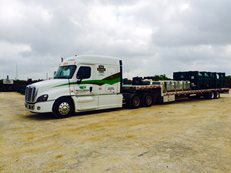Back in the 90's, I worked for a nationwide LTL carrier for about 6 years so I'm familiar with that line of work. I would leave out in the morning with 20-30 deliveries to make and once empty, start picking up. A lot of coordination goes into the route and order of stops. This planning is crucial to making the operation as efficient as possible.
Recently, I tried my hand at it again; this time with my step deck trailer and only two stops. I've tried to make this work before but usually the "partials" that are advertised on the load boards take up over half the deck space of the trailer and I can never find two partials that fit together and are along the same route. My luck changed when I was able to book a load

from Pennsylvania to Texas and loaded up two shipments (from different shippers) on my trailer. One was only 8 pallets and the other was one tank that was 25' long.
The two LTL shipments together paid much better than a full truckload would have.
Here are some key points in making a LTL run work:
-
Ensure you have the floor space for both shipments
-
Ensure you can transport the combined weight of both shipments
-
Ensure that you have enough cargo insurance for both shipments
-
Pay special attention that shipper A doesn't damage shipper B's freight when they load
-
Pay special attention that consignee A doesn't damage consignee B's freight when they unload
-
Carefully choose your route to avoid back tracking
These loads aren't multiple stop loads from the same shipper but LTL or partial shipments from different shippers. They are challenging to coordinate,
but if you can find a way to make it work, there can be a tremendous payday!